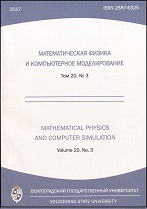|
Physics and astronomy
The hydrodinamical mechanism of jets’ formation and collimation in young star objects
N. M. Kuz'mina, S. S. Khrapova, V. V. Mustsåvoyb
a Volgograd State University
b Free researcher
Abstract:
The results of numerical hydrodynamical simulation of shock shells evolution in young star objects are presented. We have shown that during the expanding process of such shell, a slowly rotating supersonic collimated jet made of accretion disk substance forms inside the shell through the development of consequence “ejection – thorus – tornado – jet”. The mechanism of outflow’s forming and collimation is only hydrodynamical and based on the conservation law of angular momentum. It must work for all accretion-jet systems. Additional factors (such as magnetic fields) can modify such mechanism, but not eliminate it.
Let's list the main conclusions:
1) The jet is formed from the substance of the circumstellar disc. It has an angular momentum co-ordinated with the symmetry axis of the system.
2) If a one-sided ejection of matter takes place, then the shock wave, caused by it, passes through a thin circumstellar disk. Then it forms a shock wave (shell) on the other side of the disk.
3) At high initial ejection velocities, there is a significant elongation of the head of the shell. This is typical for many observable young star objects.
4) The formation of the jet is due to the presence of a long-lived torus-like vortex, in which the gas rotates both along the toroidal axis and around it.
Keywords:
jet outflows, young star objects, Herbig - Haro objects, numerical simulation, mechanisms of collimation.
Citation:
N. M. Kuz'min, S. S. Khrapov, V. V. Mustsåvoy, “The hydrodinamical mechanism of jets’ formation and collimation in young star objects”, Mathematical Physics and Computer Simulation, 20:6 (2017), 51–62
Linking options:
https://www.mathnet.ru/eng/vvgum214 https://www.mathnet.ru/eng/vvgum/v20/i6/p51
|

| Statistics & downloads: |
| Abstract page: | 153 | | Full-text PDF : | 62 | | References: | 32 |
|




 Contact us:
Contact us: Terms of Use
Terms of Use
 Registration to the website
Registration to the website Logotypes
Logotypes








 Citation in format
Citation in format 